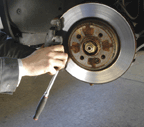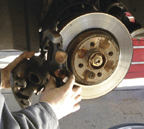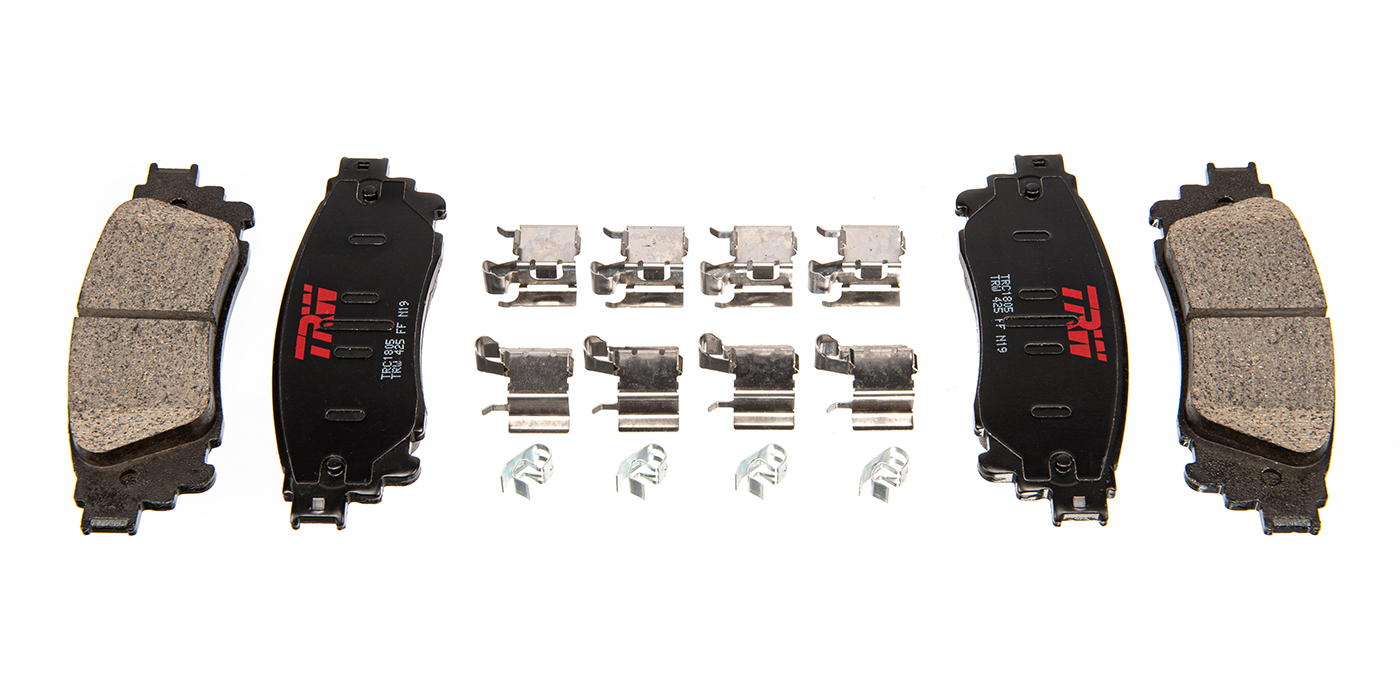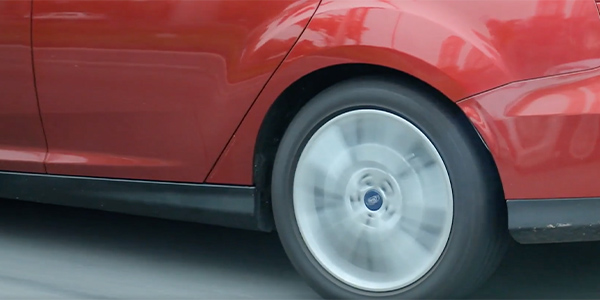Brake work continues to be a solid service opportunity for independent repair shops because brakes are items that inevitably wear out. Disc brake pads need to be replaced, and the rotors usually need to be turned or replaced. The front brakes do the most of the braking, so they receive most of the attention when the brakes are serviced. But what about the rest of the system?
Sometimes, hurried technicians just replace the front pads and turn or replace the rotors but mostly ignore the rest of the brake system. Consequently, these quickie “hang and turn” brake jobs often result in comebacks and unhappy customers because other brake problems were overlooked or missed when the vehicle was serviced. So here are some tips on how to reduce your risk of comebacks by doing a “complete” brake job on every vehicle that needs brake work.
PAD WEAR
The rate at which the linings wear out depends on the frequency of use, how hard the brakes are being applied, the temperature of the linings, the wear characteristics of the friction material itself and the location of the pads (front or rear). Larger, heavier trucks and SUVs typically wear out the front brakes faster than smaller, lighter cars. Stop-and-go city driving obviously wears down the linings faster than highway driving. So does aggressive driving. Consequently, a set of brake linings on one vehicle might last only 25,000 to 30,000 miles, when on a different vehicle they might go 50,000 or 60,000 miles.
Even so, mileage is not necessarily a good indicator of when the brake pads might need to be replaced. The only way to know if the pads are worn is to inspect them.
 As a rule, most brake pads and shoes should be replaced when the thickness of the friction material is worn down to minimum specifications (typically less than 1/8th inch of lining thickness) or when the surface of the pads or shoes are worn down flush with the tops of the rivet heads (riveted linings). Some brake pads have built-in wear indicators that generate a metallic scraping noise when the pads are worn out and need to be replaced.
As a rule, most brake pads and shoes should be replaced when the thickness of the friction material is worn down to minimum specifications (typically less than 1/8th inch of lining thickness) or when the surface of the pads or shoes are worn down flush with the tops of the rivet heads (riveted linings). Some brake pads have built-in wear indicators that generate a metallic scraping noise when the pads are worn out and need to be replaced.
If the front pads on a vehicle are worn out, don’t assume the rear pads or shoes are still fine if the mileage on the odometer is under 50,000. The rear linings typically last two to three times longer than the front linings, but not always. So inspect the rear linings, too, before making any repair recommendations.
SELLING A COMPLETE BRAKE JOB
So, the linings are worn and need to be replaced. Now what? Should you recommend replacing only the worn linings, or do the brakes need additional repairs? The answer to that question depends on the age, mileage and condition of the other parts in the brake system.
Brake linings and other parts that are obviously worn out, broken or leaking should always be replaced. But what about parts that are marginal or appear to be OK? Should drum brake hardware always be replaced, or can it be reused? Should calipers or wheel cylinders always be rebuilt or replaced if they are not leaking, or should you leave them alone? What about replacing the master cylinder in a high-mileage vehicle? Should you always flush the brake system and refill it with fresh fluid?
Some people might think you’re trying to rip them off if you recommend replacing parts that are still working but are near the end of their service life. This is a hot-button issue with consumer advocates and government regulators because they may see it as an attempt to sell unnecessary parts and services. Nobody wants to pay for parts or services they may not need, so in some states (California) there are strict regulations covering the replacement of brake components. The rules say “when” you can and cannot replace various brake system components based on wear or condition.
 FOLLOW THE MAP GUIDELINES
FOLLOW THE MAP GUIDELINES
Following the Motorist Assurance Program (MAP) voluntary repair guidelines can help you do a better job of selling brake repairs. MAP’s guidelines cover the brake inspection process and tell you when brake repairs are truly necessary, or when brake repairs can be recommended to improve braking performance or to restore the brakes to like-new condition.
Many times, the person who’s doing the brake inspection has to make a judgment call as to whether or not something should be replaced. For years, “industry accepted practice” was the criteria by which many technicians based their decisions. The trouble with this approach is that everybody has their own ideas about when certain brake parts should be replaced and why.
Take brake linings, for example. Should the linings be replaced only when they are at or below minimum thickness (as defined by the vehicle manufacturer) or is it OK to replace them if they’re still above minimum thickness but are getting thin? This is a call that many technicians have to make when doing a brake job. Though it might not be absolutely necessary to replace the rear linings right now, doing so could save the customer the cost and inconvenience of having to replace them later. The best way to handle this situation would be to discuss it with the customer and let him or her make the final call.
WEAR ISSUES
One of the major issues with selling customers a “complete” brake job is that the components in the brake system do not wear at the same rate. As we said earlier, the front brakes typically wear two to three times faster than the rear brakes. Consequently, it may not be necessary to replace the rear linings until the second or third set of front pads have been replaced.
Time, mileage and the operating environment are all factors that affect the service life of parts in the brake system, as well as the brake fluid.
Brake fluid is hygroscopic and absorbs moisture over time. As moisture accumulates in the fluid, it increases the risk of internal corrosion inside the calipers, wheel cylinders, steel brake lines, master cylinder and ABS solenoid valves. Because of this, it’s not unusual to find corrosion-related failures in these components in high-mileage vehicles that are operated in wet climates. Recommending a fluid flush for preventive maintenance would, therefore, be a valid suggestion. And if the fluid is more than three or four years old, changing it when the linings are replaced or other brake work is performed would be a good idea.
Many technicians recommend rebuilding or replacing calipers and wheel cylinders as part of a complete brake job — and with good reason. Over time, rubber seals on caliper and wheel cylinder pistons harden and lose elasticity, which may cause the seal to leak. Corrosion inside the piston bore can also accelerate seal wear. Pushing the caliper pistons back in their bores also causes the seals to rub against an area on the piston that may have become corroded and rough, which can also accelerate seal wear.
So, even if the caliper or wheel cylinder is not leaking when you replace the linings, eventually they will leak. Since there’s no way to know how long it will be before the brakes are serviced again, many technicians think that rebuilding or replacing these parts to restore the system to like-new condition reduces the risk of brake-related problems down the road — and they’re right.
The point here is components in the brake system wear at different rates that cannot be predicted by time or mileage alone. That’s why a thorough inspection of the entire brake system is so important any time brake work is needed, or any time the brakes are experiencing a problem (noise, pulling, dragging, soft pedal, etc.).
A complete brake job, therefore, is (1) inspecting the entire brake system to determine the condition of all its major components, so (2) you can recommend any repairs that are necessary to restore the brakes to proper operating condition for safe driving.
BRAKE SYSTEM INSPECTION
The brakes are the most important safety system on a vehicle, so a complete brake job should cover every aspect of the system. It should start with a thorough visual inspection of the entire brake system. This includes measuring lining thickness front and rear (which will require pulling both rear drums), checking the condition of the lines, hoses, calipers and wheel cylinders, the appearance and condition of the brake fluid, checking pedal feel and travel, and the brake and ABS warning lights (lights should come on, then go out when the ignition is turned on). Only after the inspection has been completed should any repair recommendations be made.
The ABS system is often overlooked when doing brake work on late-model cars. If the ABS warning light is on, there is a fault that needs to be investigated. This will require plugging a scan tool into the vehicle’s diagnostic connector to read out the diagnostic trouble code(s). If the light is out (and is not burned out), it’s usually safe to assume the ABS system is functioning properly — unless the vehicle has been experiencing any unusual brake problems or the ABS system has been kicking in unnecessarily when braking normally on dry pavement. This may be an issue that will require additional diagnosis.
A test drive is an excellent way to evaluate overall brake performance. But, unfortunately, many techs don’t have the time to test drive every vehicle they work on. Because of this, problems may be overlooked that may cause a future comeback.
Something else you should always do is to search for any brake-related technical service bulletins that may be out on the vehicle you’re servicing. Many TSBs are for specific complaints that may lead to a comeback if overlooked.
For example, on 2003 Mini Coopers, the right rear brake caliper may stick and drag causing brake noise or accelerated lining wear. The cause is the parking brake cable sticks in its sheath because the angle of the cable shroud is too tight near the rear wheel. The fix is to rebend the shroud slightly to lessen the angle so the cable inside won’t stick (TSB M340205). On 1998-2002 Honda Accords, 1997-2001 Preludes and 1996-2000 Civics, the brake warning light may come on after a cold start, then go out after driving a few miles. The cause may be a dirty filter inside the master cylinder reservoir cap. The filter doesn’t allow the cap to vent normally resulting in a false low fluid level warning. The fix is to replace the filter with a new one (P/N 4666-S04-J02).
WHEN REPAIRS ARE MADE
Once the entire brake system has been inspected, a recommendation to the vehicle’s owner can be made as to what parts needs to be replaced. In most instances, a “complete” brake job will include most of the following:
New linings, front and rear.
Resurfacing both rotors and drums (or replacing them if worn, cracked or hard spots are found).
Replacing drum hardware and caliper bushings/pins/sleeves.
Rebuilding or replacing calipers and wheel cylinders (depending on the mileage and condition).
Possibly replacing some brake hoses and/or the master cylinder (if leaks or problems are found).
Flushing the brake fluid and bleeding all the lines.
Inspecting wheel bearings (repacking on older vehicles).
Lubricating all critical areas such as caliper slides and shoe pads with high-temperature brake lubricant.
Checking and adjusting the parking brake.
Checking the ABS system for any fault codes, or replacing any faulty ABS components as needed (wheel speed sensors, hydraulic modulator, accumulator, pump or relay).
REPLACEMENT PARTS
When brake linings are replaced, always follow your friction supplier’s guidelines. As a rule, linings should be replaced with ones made of the same basic type of material as the original linings (or better). Replace semi-metallic with semi-metallic, ceramic with ceramic, and nonasbestos organic (NAO) with NAO — or upgrade to ceramic. The best advice here is to recommend premium-grade linings as opposed to standard or economy-grade linings. Premium linings will usually give your customer the best performance, longevity and overall value.
In recent months, several aftermarket brake suppliers have introduced new premium friction pads that promote better braking performance, quieter operation and longer pad life. Several others will be introducing new “ultra-premium” friction materials in the next couple of months. These new replacement pads claim to offer significant advantages for your customers, as well as higher profits for the shop.
Finally, don’t forget to search for TSBs that may cover parts upgrades. On 2002 Kia Optimas, for example, complaints of rear brake noise and squeaking can be eliminated by replacing not only the rear brake shoes, but also the rear brake backing plates with redesigned ones from Kia. The new brake backing plates are P/N 58355-38040 and incorporate a new dust seal.












